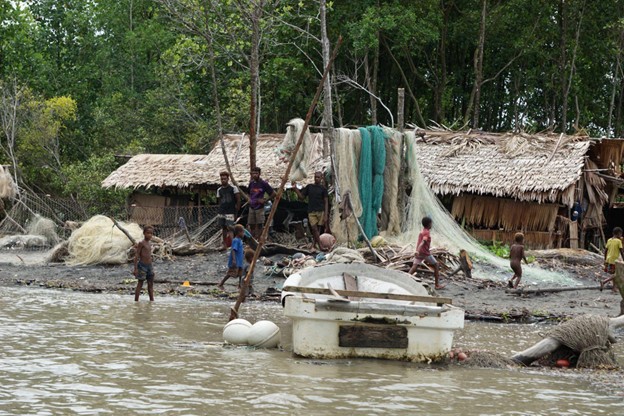Looking forward: field updates from the booming fish maw fishery in Kikori
The resilient people of the Kikori region in remote Papua New Guinea have relied upon the estuarine and coastal environments of the Kikori-Purari River Delta to sustain themselves for hundreds, possibly thousands of years. There has been a deep and intimate connection to their fishing grounds, or as they call it, their gardens, but in the last decade, this relationship has begun to shift from subsistence to commercial exploitation.

Photo © Dylan Baker | Piku Biodiversity Network
Beginning in 2015, fishing pressure in the region skyrocketed due the international demand for fish maw, the dried form of teleost swim bladder. Although this novel fishery has indeed led to better living conditions for the fishers, there are still countless ongoing issues both ecologically, as well as socially. This region is one of the few last hotspots for many Critically Endangered and Endangered species, including multiple species of sawfish and the cryptic winghead shark, which are caught as bycatch in the fish maw fishery, causing populations to rapidly deplete. The fishers themselves are being shorted profit-wise, while expats and those higher up the sales chain are thriving. Most importantly, the fishers are rapidly overexploiting the fishery resources within their customary waters, and acknowledging this, they have begun to express serious concerns for the wellbeing of their future generations.

Photo © Dylan Baker | Piku Biodiversity Network
As a result of these issues, the Piku Biodiversity Network (PBN), a Papua New Guinea based NGO conducting research and education activities throughout the region, has prioritized this fishery and emphasized the importance for continued work. In order to help propagate this endeavor, a recent scoping visit was conducted in November 2024 to gain firsthand understanding of how the fishery has shifted in the last five years.
The team, including myself, Dr. Michael Grant, and Joyce Mavera and Yolarnie Amepou from the PBN, set off on a two-week journey to visit a few long-term monitoring villages and fishing camps in order to listen to fishers’ concerns and engage in some community outreach. The first order of business was to establish a catch per unit effort (CPUE) enumerator in four villages to gain a better understanding of the intricacies of the fishery, such as how the species composition of catch is shifting, and to provide a baseline of catch rate for future reference. This process meant the team spent a few nights in each location, both to ensure data validity, as well as to propel the further training and empowerment of the local fishers who are leading the data collection. Coupled with the CPUE monitoring, we engaged one community to collect otoliths from six of the commonly caught species in the fishery, which can be used to age fishes and provide information on the age structure of the fishery and infer resilience to fishing pressure. The team trained two fishermen in Ewamu who they had previously worked with in order to conduct this collection, but to the team’s surprise, the entire community was interested and engaged in this removal process, so there was an opportunity for others to learn this skill as well! The combination of these two monitoring techniques will allow for further understanding of how sustainable this rapidly growing fishery is and provide valuable data to measure changes into the future.

Photo © Dylan Baker | Piku Biodiversity Network
Alongside the fishery monitoring, informal discussions were held with fishermen and community leaders in two of the villages, Kemei and Ekeirao. These discussions were critical to understand the concerns surrounding the fishery, the greater effort the fishermen are having to make to sustain their catch, and how future improvements could be made. Lastly, the team launched the Community Sawfish Conservation Champions program throughout the river delta. This science-based engagement and education initiative aims to encourage fishers to record and report any interactions with sawfish over the next year in hopes for greater understanding of the relative abundance and fates of bycaught sawfish, as well as increase local support for continued sawfish conservation.

Photo © Dylan Baker | Piku Biodiversity Network
Over the next year, each of these initiatives will continue to be monitored by the PBN team on the ground, but there is still much work to be done to ensure the livelihoods of the local fishermen and the protection of customary waters and the animals inhabiting it. Additional management plans for the fishery must be developed, and updated local knowledge and perceptions of both the fishery and the status of threatened species, like the sawfish, need to be pursued.
While this effort is far from over, meaningful progress depends on the strength of community-based conservation, the integration of rigorous scientific research, and the deep traditional ecological knowledge of the people who live with and care for these ecosystems. When these knowledge systems work together, both the communities and the natural world they are part of stand a real chance of thriving.
